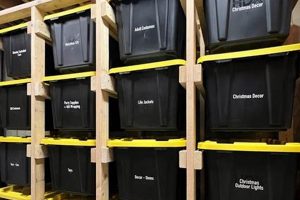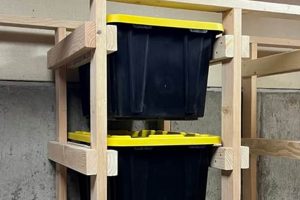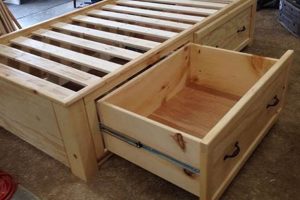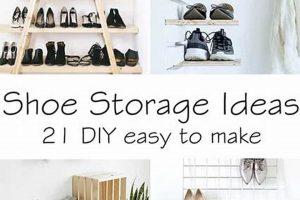The utilization of recycled corrugated fiberboard containers for organizational purposes presents a cost-effective and environmentally conscious approach to household management. These containers, commonly procured during shipping and product delivery, can be repurposed and transformed into functional units for storing diverse items, ranging from clothing and books to toys and documents. The resulting solutions are often tailored to specific needs and spatial constraints.
Repurposing these materials offers multiple advantages. Beyond the economic savings derived from avoiding the purchase of new storage solutions, it contributes to waste reduction and promotes sustainability. Historically, the practice of reusing available resources has been a cornerstone of resourcefulness, evolving from necessity to a conscious choice driven by environmental awareness and a desire for personalized living spaces. This approach aligns with contemporary values emphasizing mindful consumption and creative problem-solving.
The subsequent discussion will explore a variety of techniques for modifying and enhancing these containers to create durable, aesthetically pleasing, and practical organizational systems. Focus will be placed on structural reinforcement, decorative enhancements, and customizable design options that maximize storage efficiency and complement existing interior dcor.
Guidance for Repurposing Corrugated Fiberboard Containers for Storage
Maximizing the utility and longevity of repurposed corrugated fiberboard containers requires careful planning and execution. The following guidelines offer practical advice for transforming ordinary boxes into robust and aesthetically pleasing storage solutions.
Tip 1: Structural Reinforcement: Before commencing any decorative enhancements, prioritize the container’s structural integrity. Apply heavy-duty packing tape to all seams, both inside and outside. Consider reinforcing corners with additional cardboard pieces, secured with adhesive, to mitigate wear and tear.
Tip 2: Precise Measurement and Cutting: Employ accurate measuring techniques to ensure uniform dimensions when modifying the box’s shape or adding compartments. Utilize a sharp utility knife or box cutter, coupled with a metal ruler or straight edge, to achieve clean and precise cuts. Adherence to accurate measurements is crucial for optimal functionality.
Tip 3: Fabric or Paper Covering: Enhance the container’s aesthetic appeal by applying fabric or decorative paper. Use a suitable adhesive, such as spray adhesive or decoupage glue, to adhere the material smoothly to the exterior surface. Ensure the fabric or paper is properly stretched and free from wrinkles or air bubbles.
Tip 4: Labeling and Identification: Implement a clear and consistent labeling system to facilitate efficient retrieval of stored items. Utilize permanent markers, labels, or stencils to identify the contents of each container. Consider color-coding labels to further enhance organization.
Tip 5: Stacking Considerations: When stacking multiple containers, ensure they are of comparable size and weight distribution. Consider adding internal supports to prevent the bottom containers from collapsing under the weight of the upper ones. Avoid overloading individual containers to maintain structural stability.
Tip 6: Water Resistance Measures: Cardboard is susceptible to water damage. If the storage location is prone to humidity or potential water exposure, consider applying a water-resistant sealant or lining the container with plastic sheeting to protect the contents.
Tip 7: Handle Installation: For larger or heavier containers, install handles to facilitate easier lifting and transportation. Securely attach handles made of rope, leather, or metal to the container’s sides using screws, rivets, or strong adhesive.
These strategies offer a foundation for transforming discarded boxes into functional and aesthetically pleasing storage solutions, contributing to a more organized and sustainable living environment.
The concluding section will summarize the benefits of repurposing cardboard containers and explore future trends in sustainable storage solutions.
1. Structural Integrity
The long-term effectiveness of organizational systems derived from repurposed corrugated fiberboard containers is fundamentally contingent upon structural integrity. The inherent limitations of cardboard as a material necessitate proactive measures to augment its strength and stability. Compromised structural integrity directly correlates with diminished load-bearing capacity, increased susceptibility to deformation, and accelerated deterioration of the storage unit, thereby defeating the purpose of DIY cardboard box storage ideas.
The process of reinforcing a corrugated fiberboard container involves several techniques. Applying high-quality packing tape to all seams, both internal and external, serves to distribute stress and prevent separation under load. Corner reinforcement, utilizing additional pieces of cardboard adhered with strong adhesives, significantly enhances resistance to crushing forces. Internal supports, especially in larger containers or those intended for stacking, provide crucial vertical support, preventing collapse under the weight of stored items. A real-world example is seen in the storage of books; without adequate reinforcement, a repurposed cardboard box containing a significant volume of books will quickly buckle and fail, leading to damage and disorganization. In contrast, a reinforced box will maintain its shape and functionality, ensuring safe and organized storage.
In conclusion, the link between structural integrity and the successful deployment of repurposed cardboard containers is undeniable. Neglecting to address this critical aspect will inevitably lead to the premature failure of the storage solution. Prioritizing reinforcement techniques ensures the longevity, reliability, and overall effectiveness of these economical and sustainable DIY storage systems, maximizing their value and contributing to a more organized and efficient environment.
2. Dimensional Accuracy
Dimensional accuracy is a critical determinant of success in repurposing corrugated fiberboard containers for storage. Precise measurements and cuts directly influence the functionality, efficiency, and aesthetic appeal of the resultant storage solution. Deviations from intended dimensions can lead to poorly fitting components, wasted space, and an overall compromised design. The cause-and-effect relationship is straightforward: inaccurate measurements yield inaccurate cuts, resulting in a storage system that fails to meet its intended purpose effectively.
The importance of dimensional accuracy manifests in several practical ways. When creating compartments or dividers within a container, precise measurements ensure a snug and secure fit, preventing items from shifting or intermingling. Similarly, when constructing multi-container storage systems, consistent dimensions allow for seamless stacking and alignment, maximizing space utilization and creating a visually cohesive unit. An example is creating a set of modular drawers from repurposed boxes; if the dimensions of each drawer are not meticulously accurate, they will not slide smoothly or align properly within the supporting structure, rendering the entire system cumbersome and inefficient. Failure to achieve accurate dimensions in DIY cardboard box storage ideas, may lead to wasted material and compromised functionality.
In conclusion, dimensional accuracy constitutes a foundational element in the successful execution of corrugated fiberboard container repurposing. Its influence extends from the basic functionality of individual storage units to the overall effectiveness of complex storage systems. While challenges exist in achieving perfect precision, the pursuit of dimensional accuracy remains paramount in realizing the full potential of this cost-effective and sustainable approach to organization.
3. Aesthetic Enhancement
Aesthetic enhancement transforms repurposed corrugated fiberboard containers from utilitarian objects into integrated components of a living or working space. While functionality remains paramount, visual appeal influences user engagement and satisfaction. The application of aesthetic principles elevates the perceived value of storage solutions and contributes to a more harmonious and organized environment.
- Surface Treatment
Surface treatment encompasses a range of techniques for altering the exterior appearance of a container. This includes painting, covering with fabric or decorative paper, applying adhesive vinyl, or employing decoupage methods. The choice of material and technique should complement the existing interior dcor and reflect personal preferences. For example, a minimalist workspace might benefit from containers painted in neutral tones with clean lines, while a child’s playroom could incorporate brightly colored fabrics or patterned paper. In practice, Surface Treatment to diy cardboard box storage ideas allows to visually blend in with the environment.
- Hardware Integration
The addition of hardware, such as handles, knobs, or decorative closures, enhances both the functionality and visual appeal of the storage unit. Handles facilitate easier lifting and transportation, while decorative closures add a touch of elegance or personality. The selection of hardware should consider both the weight of the stored items and the overall aesthetic design. For instance, leather handles can impart a rustic or industrial feel, while polished metal knobs can complement a more modern aesthetic. This addition of hardware is the key to increase DIY cardboard box storage ideas value.
- Shape Modification
Beyond simply covering a standard box, shape modification involves altering the container’s form to better suit its intended purpose or aesthetic vision. This may involve cutting the box into a different shape, adding structural elements to create shelves or compartments, or combining multiple boxes to form a larger, more complex storage unit. Shape modification requires careful planning and execution to maintain structural integrity and achieve the desired aesthetic outcome. For example, corrugated fiberboard can be fashioned into geometric shapes, or stacked in irregular configurations to become diy cardboard box storage ideas.
- Personalization and Embellishment
Personalization involves adding unique touches that reflect individual style or interests. This may include stenciling, hand-painting, adding embellishments such as ribbons or buttons, or incorporating personalized labels. The goal of personalization is to create a storage solution that is not only functional but also a reflection of the user’s personality and creativity. For example, using stencils to paint family names or meaningful quotes on the boxes will enhance the personalized value and make it distinctively DIY cardboard box storage ideas.
These facets, when considered holistically, demonstrate that aesthetic enhancement is not merely about making storage units look “pretty.” It’s a process of integrating functionality, personal expression, and design principles to create storage solutions that enhance the overall living or working environment, while also being an expression of creative DIY cardboard box storage ideas.
4. Content Identification
Effective content identification is a cornerstone of successful organizational systems utilizing repurposed corrugated fiberboard containers. The practice involves implementing a clear and consistent method for denoting the contents of each storage unit. Without proper content identification, the benefits of a meticulously constructed and aesthetically pleasing storage system are significantly diminished, leading to inefficiencies and frustration. A lack of identification effectively negates the advantages of organized storage, transforming the system into a collection of opaque containers requiring exhaustive searching for desired items; therefore, this affects the value of diy cardboard box storage ideas.
The methods for achieving effective content identification are diverse, ranging from simple labeling to more sophisticated systems. Hand-written labels, employing permanent markers on adhesive labels, provide a basic and cost-effective solution. Stenciled lettering offers a more visually consistent and durable alternative. Photo-based labeling, wherein images of the contents are affixed to the container, proves particularly useful for identifying items without requiring written language or for distinguishing between similar items. Digital labeling systems, utilizing barcode scanners or QR codes linked to inventory databases, represent a more advanced approach, suitable for larger-scale storage applications or those requiring precise tracking. For instance, in a home office setting, unlabeled containers filled with documents necessitate a time-consuming manual search process. Conversely, clearly labeled containers allow for the immediate retrieval of specific files, enhancing productivity and reducing stress. This enhancement is the very goal of diy cardboard box storage ideas.
In summary, content identification is not merely an ancillary component of repurposed corrugated fiberboard storage systems; it is an integral element that directly influences their overall effectiveness. Implementing a consistent and appropriate identification system is crucial for maximizing the benefits of organized storage, enabling efficient retrieval, and maintaining a clutter-free environment. While challenges may arise in selecting the most suitable identification method or maintaining consistency across a large storage system, the effort invested in content identification yields substantial returns in terms of improved organization and streamlined workflow, especially as diy cardboard box storage ideas, grows.
5. Stacking Stability
Stacking stability is paramount in organizational systems employing repurposed corrugated fiberboard containers. The capacity to vertically arrange storage units maximizes space utilization, particularly in environments with limited square footage. However, inherent material properties and construction techniques directly influence the load-bearing capacity and overall stability of stacked configurations. Compromised stacking stability poses risks, including potential collapse, damage to stored items, and personal injury. Therefore, addressing stacking stability concerns is integral to the safe and effective implementation of do-it-yourself cardboard box storage ideas.
- Weight Distribution
Uneven weight distribution significantly impacts stacking stability. Containers with a concentration of weight on one side or corner are prone to tipping or collapsing when stacked. Distributing weight evenly across the base of each container is crucial. This can be achieved by strategically arranging contents within each unit, placing heavier items at the bottom and lighter items towards the top. In practice, a box filled unevenly will tilt due to an imbalance and if this situation were to occur within a stack, this would be a risk to the safety to the stack. Careful packing prevents shifting of internal weight and improves diy cardboard box storage ideas durability.
- Reinforcement Techniques
Various reinforcement techniques enhance the load-bearing capacity of corrugated fiberboard containers. Applying heavy-duty packing tape to all seams, particularly on the bottom and corners, strengthens the overall structure. Internal supports, such as additional cardboard dividers or wooden frames, provide added vertical support, preventing collapse under the weight of upper containers. Interlocking designs, wherein containers interlock or nest within each other, further enhance stability by distributing the load and preventing lateral movement. For example, a frame made of thin plywood could be placed inside the container to improve stacking stability. A box reinforced is able to sustain a higher load and enhances diy cardboard box storage ideas overall.
- Surface Friction
The coefficient of friction between stacked containers directly affects stability. Smooth surfaces, such as glossy cardboard or plastic, offer minimal friction, increasing the likelihood of slippage. Roughening the surface with sandpaper or applying non-slip pads improves friction, preventing lateral movement and enhancing overall stability. Surface characteristics such as rough cardboard, versus waxed or coated cardboard, make a tremendous difference in the structural support of diy cardboard box storage ideas.
- Container Dimensions and Uniformity
Using containers of comparable dimensions promotes stacking stability. Stacking dissimilar containers creates uneven weight distribution and increases the risk of collapse. Furthermore, dimensional uniformity ensures consistent alignment, preventing lateral shifting and maximizing space utilization. An instance may be using boxes with similar length and width dimensions, but varying height dimensions, may still be safely stacked with heavy items inside the larger boxes. The concept of uniformity of boxes enhances diy cardboard box storage ideas success.
These facets, when comprehensively addressed, significantly enhance the safety and effectiveness of stacked corrugated fiberboard storage systems. Prioritizing weight distribution, employing reinforcement techniques, optimizing surface friction, and ensuring dimensional uniformity are crucial steps in mitigating risks and maximizing the benefits of vertical storage solutions. Therefore, the combination of these factors elevates not only the stability of each container, but improves diy cardboard box storage ideas altogether.
6. Environmental Protection
The connection between environmental protection and the repurposing of corrugated fiberboard containers for storage stems from a fundamental principle of waste reduction and resource conservation. The creation of new storage units typically involves the consumption of raw materials, energy expenditure for manufacturing, and transportation contributing to carbon emissions. Transforming discarded cardboard boxes into functional storage solutions mitigates the environmental impact associated with the production of new goods. This diversion of materials from the waste stream reduces landfill volume, conserves natural resources like trees and water, and diminishes the energy required for recycling processes.
The practical significance of this connection lies in its accessibility and scalability. Reusing cardboard boxes requires minimal investment, technical skills, or infrastructure, making it a feasible option for individuals, households, and organizations alike. For instance, a business can significantly reduce its environmental footprint by encouraging employees to repurpose shipping boxes for organizing office supplies, documents, or personal belongings. A school can incorporate cardboard box repurposing into art projects or classroom organization initiatives, instilling environmentally conscious habits in students. Such initiatives not only reduce waste but also raise awareness about sustainable practices, promoting a more responsible approach to resource management as part of diy cardboard box storage ideas.
Despite the inherent environmental benefits, challenges remain. Ensuring the long-term durability of repurposed cardboard containers requires attention to structural integrity and protection from moisture. Promoting widespread adoption necessitates addressing potential perceptions of aesthetic inferiority and demonstrating the versatility and adaptability of cardboard-based storage solutions. However, the growing awareness of environmental concerns and the increasing emphasis on sustainable living practices suggest that repurposing corrugated fiberboard containers will continue to gain traction as a viable and environmentally responsible storage option as part of diy cardboard box storage ideas.
Frequently Asked Questions
The following questions address common inquiries regarding the repurposing of corrugated fiberboard containers for storage purposes. The intent is to provide clear, concise answers based on practical experience and established best practices.
Question 1: What types of adhesive are most suitable for reinforcing corrugated fiberboard containers?
Heavy-duty packing tape is recommended for reinforcing seams. For adhering additional cardboard supports or decorative materials, consider using construction adhesive or hot melt adhesive. Ensure the adhesive is compatible with both the cardboard and the overlay material to avoid delamination.
Question 2: How can one prevent corrugated fiberboard containers from attracting pests or insects?
Maintain a clean storage environment, free from food debris or moisture. Consider applying a non-toxic insecticide spray to the exterior of the container. Regularly inspect the containers for signs of infestation and take appropriate action if necessary.
Question 3: Is it possible to create waterproof or water-resistant corrugated fiberboard storage units?
While corrugated fiberboard is inherently susceptible to water damage, protective measures can enhance its resistance. Applying a waterproof sealant or lining the container with plastic sheeting can provide a degree of protection. However, avoid storing moisture-sensitive items in cardboard containers exposed to humid or wet conditions.
Question 4: What are the best practices for disassembling repurposed corrugated fiberboard containers for recycling?
Remove any tape, labels, or non-cardboard materials. Flatten the container to reduce its volume. If possible, separate the different layers of cardboard to facilitate more efficient recycling. Dispose of the flattened cardboard in accordance with local recycling regulations.
Question 5: How does one address concerns about the potential for off-gassing from corrugated fiberboard or adhesives?
Select corrugated fiberboard that is certified as low-VOC (Volatile Organic Compound). Allow newly constructed or modified containers to air out in a well-ventilated area before storing sensitive items. Consider using natural adhesives, such as wheat paste, as an alternative to synthetic adhesives.
Question 6: What safety precautions should be observed when cutting or modifying corrugated fiberboard containers?
Use a sharp utility knife or box cutter with a retractable blade. Employ a metal ruler or straight edge to guide cuts. Wear protective gloves to prevent cuts or abrasions. Work on a stable, non-slip surface to avoid accidents. Always cut away from the body.
These responses offer practical guidance for addressing common concerns associated with the utilization of repurposed corrugated fiberboard containers. Adherence to these recommendations will enhance the safety, durability, and overall effectiveness of storage solutions. Remember, the key is to apply diy cardboard box storage ideas with these concerns in mind.
The subsequent section will summarize the key benefits and drawbacks of repurposing corrugated fiberboard containers, providing a balanced perspective on this storage approach.
Conclusion
The preceding exploration of corrugated fiberboard container repurposing for organizational systems reveals a confluence of benefits and limitations. The practice presents a cost-effective and environmentally conscious alternative to conventional storage solutions. It fosters resourcefulness and minimizes waste. However, its inherent susceptibility to environmental factors and load-bearing constraints necessitate careful planning and execution. Factors like structural integrity, dimensional accuracy, aesthetic enhancement, content identification, stacking stability, and environmental protection are critical determinants of success. A failure to address these considerations compromises the viability of the storage system.
Ultimately, the informed application of these principles determines whether “diy cardboard box storage ideas” transcends a mere cost-saving measure and becomes a sustainable and effective contribution to organizational efficiency and responsible resource management. Continued innovation in materials and techniques may further refine this approach. This leads to maximizing its potential and mitigating its drawbacks, enhancing its relevance in an increasingly resource-conscious world. The challenge lies in optimizing functionality and durability without compromising the core values of sustainability and affordability.







![Build Your Own! Storage Bin Rack DIY Project [Easy] The DIY Hub: Creative Crafts, Repairs & Life Hacks Build Your Own! Storage Bin Rack DIY Project [Easy] | The DIY Hub: Creative Crafts, Repairs & Life Hacks](https://craftingdiycenter.com/wp-content/uploads/2025/07/th-1825-300x200.jpg)